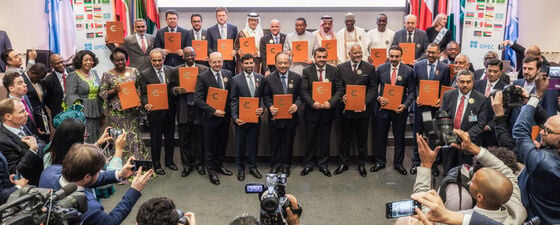Is it time for the world’s most influential oil players – OPEC, North America and Russia – to engage and take collective leadership and responsibility? 2020 has already demonstrated that stabilizing oil markets has passed the politics of finger pointing and blaming each other.
2020 will go down in history as a major oil market crash worldwide. ©Nicolasmenijes/Dreamstime
We are living in troubled times. A year ago, no one could have envisioned that in 2020 a serial microscopic killer would disrupt life and halt the world. The coronavirus pandemic has overshadowed every facet of our society, and rightly so. Nevertheless, an economic crisis of global scale is also growing before our eyes. The oil market crash is an alarming symptom of this weakened economy which hurts everybody, whether or not they are affected by coronavirus. Oil prices fell by 75% in the first quarter of 2020: from $60 a barrel in early January to the $10s a barrel (for West Texas Intermediate crude) in late March and April. These prices are not only the lowest in the past two decades but also far below the breakeven points for producing oil in the US and most other countries. Obviously, the economic fallout of the coronavirus pandemic has considerably reduced oil consumption worldwide, but the oil production feud between Russia and Saudi Arabia was also an important factor in lowering oil prices.
However, to better understand the current story of low oil prices we have to go back several years ago when US shale oil production kept increasing, and tension between OPEC, Russia, and the US oil producers started – a “who will blink first” game. Although oil consumption and prices will rise in the post-coronavirus world, as long as the top oil producing countries do not collectively act to stabilize the oil market, the price crisis will continue for years with varying (and at times shocking) magnitudes.
Oil prices for OPEC Basket benchmark crude, 1 January to 20 April 2020. (Data from OPEC).
Cheap Oil is Costly
Cheap gasoline (petrol) is good for consumers and for filling storages and strategic reserves but only for a brief time. The storages are finite, and for people in lockdown low oil prices are irrelevant. On 20 April in New York, just a day before the oil trades for the month of May ended, futures prices of WTI for May dropped below zero; negative price is unprecedented in the entire history of oil. The reason was not only less demand for oil but more importantly full inventories and lack of spare storage at Oklahoma’s Cushing, the delivery route for WTI. It was a classic oil glut problem. (Brent crude in Europe escaped this historic price failure because it can be shipped from several offshore points).
Currently, cheap oil is mostly helping countries heavily dependent on oil imports such as China, India and Japan, and also the delivery costs of online trade companies like Amazon, which are already making huge profits in these odd times.
Oil price wars and volatility hurt not only oil companies but also other stocks and investments sensitive to oil. The oil industry worldwide employs tens of millions of people. Fatih Birol, the International Energy Agency’s director, recently remarked that 50 million jobs related to oil refining and retail sale are currently at risk. Prolonged cheap oil will do more damage to American and global energy sectors including their lending banks, investors, and other commercial enterprises associated directly or indirectly with oil.
Moreover, cheap oil is already hurting the oil producing countries in Asia, Africa and South America who need financial resources to fight the coronavirus.
US Faces OPEC and Russia
Since late 2016, when OPEC Plus formed as a collaboration with Russia (as an observer not a member), the oligopoly’s policies have been in effect set by Saudi Arabia and Russia. These two countries agreed to regulate production to keep oil prices at a reasonable level for the producers. Early this year, however, Russia refused to decrease its production, probably aiming to weaken American shale oil producers at their vulnerable time. Saudi Arabia then joined the feud by offering purchase discounts and also announced plans to increase oil production in order to keep its share of oil sales worldwide. In other words, these two countries essentially wanted to maintain their oil revenues by selling more oil at cheaper prices. So even though Russia and Saudi Arabia were politically in disagreement, their actions had the same impacts on oil prices and American oil producers.
The conclusion of the 6th OPEC and non-OPEC Ministerial Meeting held in Vienna, Austria, on Tuesday, 02 July 2019.
As a result of reduced demand the world market was oversupplied with oil. The prospect of increased oil production further lowered oil prices. The White House has called on the Saudis and Russians to decrease their oil production. Political pressure may be helpful briefly but it does not offer a fundamental solution.
In early April, OPEC Plus announced that they would cut their oil production by 9.7 MMbopd for the months of May and June (and then 8 MMbopd for the rest of 2020). This announcement has not raised oil prices (as of late April). Some have criticized it as a “too little, too late” decision, and that there should be a production cut of 20 MMbopd.
OPEC Plus’s decision was out of self-interest calculations as low oil prices also hurt their economies and they need somewhat higher prices to balance their budgets and welfare systems that are heavily dependent on oil revenues. However, they also maintain that all major oil producers, including North America, should join OPEC and Russia to cut oil production. The US has a different perspective: in a low-price oil market, American oil producers will organically reduce their production. This market forcing is true for all oil producers with varying price tolerance levels; nevertheless, it leaves the oil markets porous to volatility.
Top five oil producers 1980-2019 (Source: US Energy Information Administration).
In 2015, thanks to its shale oil revolution, the US lifted its forty-year ban on crude export. Since then the US has increasingly become an exporter of oil and hydrocarbon gas liquids. In 2019, the US became Number 1 oil producer in the world. OPEC and Russia thus no longer view the US as a client but as an emerging rival in the world oil market. They know that the US shale industry will not vanish, and that their oil exports to the US are far less than those of Canada and Mexico, who account for 55% of US crude imports. OPEC’s crude exports to the US decreased from 6 MMbopd in 2008 to 1.6 MMbopd in 2019, while Canada’s oil exports to the US increased from 2.5 to 4.4 MMbopd during this period. The US is a declining market for OPEC. Moreover, last December’s US sanctions on Russia’s Nord Stream 2 pipeline to transport natural gas to European Union was perceived as a sign of the US strategy to expand its own petroleum export to Europe.
As a thought experiment let’s imagine the US joins with OPEC Plus as an observer. What will be the main point of negotiation, monitoring, and regulation? Probably, it will not be how much oil the US or any other country consumes internally, but how much oil it will export: recall that OPEC stands for the Organization for Petroleum Exporting Countries. The joint US engagement with OPEC Plus would thus send the strongest message to markets. (Indeed, in the post-pandemic world, consolidations among American oil companies will be necessary to revive the country’s oil industry.)
Alternatively, the US can decouple its market from the world by fixing a higher price for its domestic oil and putting tariffs on any imported cheaper oil. This will protect the US oil shale producers and will also provide huge revenues for the US government. However, American consumers will pay higher prices for oil (as well as many other products downstream of oil). Moreover, American oil companies will have little incentives to export their oil while the overseas prices are lower.
Oil in Hibernation but Will Rise Again
As a large proportion of the world’s population continues to remain in lockdown, global consumption remains low.
To keep national economies alive in the wake of the pandemic, many governments, following the ideas of the British economist John Maynard Keynes who suggested government interventions during the Depression Years of the 1930s, are offering money to consumers and businesses. In this way, economic enterprises do not collapse and consumption stimulates economic activities. However, these stimulation packages will not help revive the oil market as long as lockdowns and restrictions on transportation are in place. Oil will be in hibernation for months. When economic and industrial activities, especially transportation, pick up again, oil consumption and prices will also rise. However, oil market stability in that near future will largely depend on what unified policies the oil producing countries adopt today.
Before the coronavirus pandemic, the world was using over 100 MMbopd. Russia and Saudi Arabia produced only 20% of the world’s oil demand; therefore, these two countries cannot control prices for long. In fact, the good news is that no single company or country can control oil prices for long; the bad news is that nobody is in charge of oil prices – hence the market volatility and uncertainties.
The Ghost of Pérez Alfonzo
Daniel Yergin has shown in his masterpiece The Prize: The Epic Quest for Oil, Money & Power that the modern history of oil has always been associated with political forces and interventions. Sooner or later, the world’s most influential oil players – OPEC, Russia, North America and a few others – will need to talk and take collective leadership and responsibility. Oil market stability is essential to the economic growth of the world in the near future, but it requires cooperation for supply and demand balance, rather than price wars and tensions.
This year OPEC celebrates its 60th anniversary. Its founding father was Venezuelan oil minister Pérez Alfonzo (1903-1979), who actually modeled OPEC on the Texas Railroad Commission (TRC). During the 1930s-60s the TRC, based in the most petroliferous state in the USA, regulated oil prices by setting production allocations to oil companies in order to safeguard the wellbeing of the US domestic oil industry. Alfonzo, who lived in exile in the US in the early 1950s, conceived the idea of OPEC after studying the success of the TRC. Alfonzo was also surprisingly an environmentalist; he believed that oil should not be wasted or overproduced. Sometimes the best and cheapest way to store oil is not to produce it.
Many experts and authors have described OPEC as a failed cartel. This may be true, but given the oil crisis of 2020 how do we define success in an interlinked fluid oil market? This question is critical as no country that imports or exports oil can isolate itself from the world oil economy and diplomacy.
In the coming decades it is expected that the world will reduce its dependency on oil, but the current glut of cheap oil and natural gas will discourage development of renewable energy systems. Evidence of collective leadership and responsibility from countries on the question of oil supply will also boost public confidence in their ability to manage the energy transition.
About the author…
Rasoul Sorkhabi is a research professor at the University of Utah and a former editor of Oil Industry History. He is currently working on a book on oil and OPEC. He is also a contributing editor for GEO ExPro, and his previous articles on oil economy include:
Sorkhabi, Rasoul (2010) The Road to Opec 1960. Geo Expro, vol. 7, no. 5, p. 68-73.
Sorkhabi, Rasoul (2015) The First Oil Shock. Geo Expro, vol. 12, no. 3, pp. 92-96.
Sorkhabi, Rasoul (2017) Oil Prices and Crises: A Brief History of Oil Booms and Busts, Part I. GeoExpro, vol. 14, no. 4, p. 52-56
Sorkhabi, Rasoul (2017) Riding the Switchback: A Brief History of Oil Booms and Busts, Part II. GeoExpro, v. 14, no. 5, p. 56-60
You may also like…
Oil Crisis 2020: Prospects for the Near Future
Rasoul Sorkhabi, Ph.D.
We all are concerned about the Covid-19 pandemic as well as the resultant economic crisis. The oil market crash of 2020 is a visible indication of this crisis. When will this end? This question is on everyone’s mind, but ‘when’ is also related to ‘how’. Here we examine some fundamental factors, trends, and scenarios.
This article appeared in July, 2020





